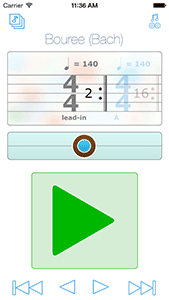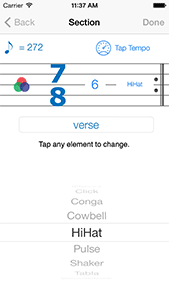Code Samples
I am generally unable to share the most interesting code I have
written, because it is either valuable or does not belong to me. I
am happy to show and demonstrate this code in person, but I will not
share it on the web.
The samples here are intended to demonstrate my attention to coding
standards and the correct use of comments. This is code that I am
proud of, that I own entirely, and am able to share.
FizzBuzz (Java)
Let's get this out of the way right now.
public class FizzBuzz {
public static void main(String[] args) {
fizzBuzz();
}
static void fizzBuzz() {
try {
for (int i = 1; i <= 100; i++)
fbRender(i, System.out);
} catch (IOException ioe) {
ioe.printStackTrace();
}
}
static void fbRender(int i, OutputStream out) throws IOException {
if ((i % 15) == 0)
out.write("FizzBuzz\n".getBytes());
else if ((i % 3) == 0)
out.write("Fizz\n".getBytes());
else if ((i % 5) == 0)
out.write("Buzz\n".getBytes());
else
out.write((i + "\n").getBytes());
}
}
Defensive Quicksort (C)
This is a simple integer array sort, but with a demonstration of the
defensiveness we practice for MagnaStor's kernel module. The
error handling mechanism here is purposefully grossly inadequate
for brevity. Our MOH framework features an error handling system
that is fully featured, robust, and elegant.
The BSD
KNF
coding style here is indicative of the high value I place on
adhering to (and strictly enforcing) a coding standard.
#include <stdarg.h>
#include <stdlib.h>
#include <stdio.h>
#include <time.h>
#define ERR_INVALARG 1U
#define MAXERRSZ 1024
#define ERROR(code, ...) \
_error(code, __FILE__, __LINE__, __VA_ARGS__)
typedef enum { ASCENDING, DESCENDING } direction;
#define RANDBOUND 1000
#define NUMCOUNT 25
int
_error(unsigned int code, const char *file, int line, const char *fmt, ...) {
char msg[MAXERRSZ];
va_list ap;
int sz;
va_start(ap, fmt);
sz = vsnprintf(msg, sizeof (msg), fmt, ap);
va_end(ap);
if (sz >= (sizeof (msg) - 1))
fprintf(stderr,
"error message buffer (%lu) too small for message (%u)\n",
sizeof (msg), sz);
else
fprintf(stderr, "error (%u): %s[+%d]: %s\n", code, file, line, msg);
return (code);
}
void
init(void) {
time_t t;
srand((unsigned) time(&t));
}
int
populatearray(int *arr, int arrcount) {
int err;
int i;
if (arr == NULL) {
err = ERROR(ERR_INVALARG, "arr is null");
return (err);
}
if (arrcount <= 0)
return (0);
for (i = 0; i < arrcount; i++)
arr[i] = (rand() % RANDBOUND);
return (0);
}
void
dumparray(int *arr, int arrcount) {
int err;
int i;
if (arr == NULL)
return;
if (arrcount <= 0)
return;
for (i = 0; i < arrcount; i++)
printf("\t[%d]: %d\n", i, arr[i]);
}
void
swap(int *i, int *j) {
int tmp;
if (i == NULL)
return;
if (j == NULL)
return;
tmp = *i;
*i = *j;
*j = tmp;
}
int
staysleft(int piv, int val, direction dir) {
if ((val <= piv) && (dir == ASCENDING))
return (1);
if ((val >= piv) && (dir == DESCENDING))
return (1);
return (0);
}
int
staysright(int piv, int val, direction dir) {
if ((val >= piv) && (dir == ASCENDING))
return (1);
if ((val <= piv) && (dir == DESCENDING))
return (1);
return (0);
}
int
partition(int *arr, int arrcount, int start, int end, direction dir, int *res) {
int right;
int done;
int left;
int err;
int piv;
if (arr == NULL) {
err = ERROR(ERR_INVALARG, "arr is null");
return (err);
}
if (res == NULL) {
err = ERROR(ERR_INVALARG, "res is null");
return (err);
}
if (arrcount <= 1)
return (0);
/*
* The joesort strategy relies on a terminal case (when the array count is
* even) where the end argument may become negative. A negative end value
* that is less than start is expected.
*/
if (start >= end)
return (0);
/*
* If we reach this point, both start and end must be exactly in-bounds.
*/
if ((start < 0) || (start >= arrcount)) {
err = ERROR(ERR_INVALARG,
"start value (%d) out of bounds (%d)", start, arrcount);
return (err);
}
if ((end < 0) || (end >= arrcount)) {
err = ERROR(ERR_INVALARG,
"end value (%d) out of bounds (%d)", end, arrcount);
return (err);
}
piv = arr[start];
left = start + 1;
right = end;
done = 0;
while (done == 0) {
while ((left <= right) && staysleft(piv, arr[left], dir))
left++;
while (staysright(piv, arr[right], dir) && (right >= left))
right--;
if (right < left)
done = 1;
else
swap(&arr[left], &arr[right]);
}
swap(&arr[start], &arr[right]);
*res = right;
return (0);
}
int
joesort(int *arr, int arrcount, int start, int end, direction dir) {
int err;
int p;
if (arrcount <= 0)
return (0);
/*
* The joesort strategy relies on terminal cases where the start value may
* reach arrcount. A greater value indicates programmer error.
*/
if ((start < 0) || (start > arrcount)) {
err = ERROR(ERR_INVALARG,
"start value (%d) out of bounds (%d)", start, arrcount);
return (err);
}
/*
* The joesort strategy relies on terminal cases where the end value may
* dip down to -1. A lesser value indicates programmer error.
*/
if ((end < -1) || (end >= arrcount)) {
err = ERROR(ERR_INVALARG,
"end value (%d) out of bounds (%d)", end, arrcount);
return (err);
}
/*
* This check appears after the validity checks above so that it doesn't
* hide clear cases of programmer error.
*/
if (start >= end)
return (0);
err = partition(arr, arrcount, start, end, dir, &p);
if (err != 0) {
ERROR(err, "failed to partition (%d to %d)", start, end);
return (err);
}
err = joesort(arr, arrcount, start, p - 1, dir);
if (err != 0) {
ERROR(err, "failed to sort low partition (%d to %d)", start, (p - 1));
return (err);
}
err = joesort(arr, arrcount, p + 1, end, dir);
if (err != 0) {
ERROR(err, "failed to sort high partition (%d to %d)", p + 1, end);
return (err);
}
return (0);
}
int
main(void) {
int arr[NUMCOUNT];
int err;
init();
err = populatearray(arr, NUMCOUNT);
if (err != 0) {
ERROR(err, "failed to populate array (size %lu)", NUMCOUNT);
return (err);
}
printf("before:\n");
dumparray(arr, NUMCOUNT);
err = joesort(arr, NUMCOUNT, 0, NUMCOUNT - 1, ASCENDING);
if (err != 0) {
ERROR(err, "failed to sort array (size %lu)", NUMCOUNT);
return (err);
}
printf("\nafter:\n");
dumparray(arr, NUMCOUNT);
return (0);
}
Grid Toy (Javascript)
This class is part of an internal tool I built for
the development of a mobile / browser game I am working on called
"Evolvis". The game involves creatures arranged in a grid who form
patterns (think "Conway as a slot machine" mini-game
within a greater, space-based IP). The game recognizes patterns with
a brute-force bitmask stenciling strategy. I created GridToy as a
tool to automatically generate the bitmask arrays for each cardinal
rotation and reflection, with deduplication.
/**
* Terminology
* ===========
*
* Primary Table:
* --------------
* The larger, leftmost, interactive table with which the user defines the
* shape.
*
* Normal Table:
* -------------
* The preview table which represents one of the four cardinal rotations.
*
* Horizontal Reflection Table:
* ----------------------------
* The preview table which is a horizontal reflection of one of the four
* cardinal rotations.
*
* Vertical Reflection Table:
* --------------------------
* The preview table which is a vertical reflection of one of the four cardinal
* rotations.
*/
function GridPreview(orientation, id, rows, cols) {
this.COORDS_NORMAL = 1;
this.COORDS_HREFLECT = 2;
this.COORDS_VREFLECT = 3;
this.orientation = orientation;
this.id = id;
this.normalKey = this.orientation + "N";
this.hReflectKey = this.orientation + "HR";
this.vReflectKey = this.orientation + "VR";
this.normalWrapObj = $("#" + id + "Normal");
this.hReflectWrapObj = $("#" + id + "HReflect");
this.vReflectWrapObj = $("#" + id + "VReflect");
this.normalIDGrid = new Array();
this.hReflectIDGrid = new Array();
this.vReflectIDGrid = new Array();
if (orientation == 90 || orientation == 270) {
this.cols = rows;
this.rows = cols;
} else {
this.cols = cols;
this.rows = rows;
}
}
GridPreview.prototype.update = function() {
this.clear();
this.createTables();
}
GridPreview.prototype.clear = function() {
this.normalWrapObj.html("");
}
GridPreview.prototype.createTables = function() {
var html;
html = this.getPreviewTableHTML(this.orientation, this.COORDS_NORMAL,
this.normalIDGrid);
this.normalWrapObj.html(html);
html = this.getPreviewTableHTML("horiz", this.COORDS_HREFLECT,
this.hReflectIDGrid);
this.hReflectWrapObj.html(html);
html = this.getPreviewTableHTML("vert", this.COORDS_VREFLECT,
this.vReflectIDGrid);
this.vReflectWrapObj.html(html);
}
GridPreview.prototype.getTransformedCoords = function(type, row, col) {
switch(type) {
case this.COORDS_NORMAL:
return (this.getTransformedCoordsNormal(row, col));
case this.COORDS_HREFLECT:
return (this.getTransformedCoordsHReflect(row, col));
case this.COORDS_VREFLECT:
return (this.getTransformedCoordsVReflect(row, col));
default:
alert("invalid type: " + type);
}
}
GridPreview.prototype.getTransformedCoordsNormal = function(row, col) {
var res;
res = [];
if (this.orientation == 0) {
res[0] = this.rows - row - 1;
res[1] = col;
} else if (this.orientation == 90) {
res[0] = col;
res[1] = row;
} else if (this.orientation == 180) {
res[0] = row;
res[1] = this.cols - col - 1;
} else {
res[0] = this.cols - col - 1;
res[1] = this.rows - row - 1;
}
return (res);
}
GridPreview.prototype.getTransformedCoordsHReflect = function(row, col) {
var res;
res = [];
if (this.orientation == 0) {
res[0] = this.rows - row - 1;
res[1] = this.cols - col - 1;
} else if (this.orientation == 90) {
res[0] = this.cols - col - 1;
res[1] = row;
} else if (this.orientation == 180) {
res[0] = row;
res[1] = col;
} else {
res[0] = col;
res[1] = this.rows - row - 1;
}
return (res);
}
GridPreview.prototype.getTransformedCoordsVReflect = function(row, col) {
var res;
res = [];
if (this.orientation == 0) {
res[0] = row;
res[1] = col;
} else if (this.orientation == 90) {
res[0] = col;
res[1] = this.rows - row - 1;
} else if (this.orientation == 180) {
res[0] = this.rows - row - 1;
res[1] = this.cols - col - 1;
} else {
res[0] = this.cols - col - 1;
res[1] = row;
}
return (res);
}
GridPreview.prototype.getPreviewTableHTML = function(title, type, idGrid) {
var xformed;
var rowArr;
var alive;
var html;
var cls;
var eid;
html = title + "<br>";
html += "<table cellspacing='1' cellpadding='0' border='0' " +
"style='margin-bottom: 1em;'>";
for (var i = 0; i < this.rows; i++) {
html += "<tr>";
rowArr = new Array();
for (var j = 0; j < this.cols; j++) {
xformed = this.getTransformedCoords(type, i, j);
eid = this.id + "N_" + xformed[0] + "_" + xformed[1];
rowArr.push(eid);
alive = this.primaryCellIsAlive(xformed[0], xformed[1]);
cls = "previewcelldiv";
if (alive)
cls += " alive";
html += "<td>";
html += "<div id='" + eid + "' class='" + cls + "'>";
html += "</div>";
html += "</td>";
}
html += "</tr>";
idGrid.push(rowArr);
}
html += "</table>";
return (html);
}
/**
* Returns true if the cell at position row,col is alive in the primary table.
*/
GridPreview.prototype.primaryCellIsAlive = function(row, col) {
var eObj;
eObj = $("#" + row + "_" + col);
if (eObj.css("background-color") == "rgb(0, 0, 0)")
return (false);
return (true);
}
GridPreview.prototype.getComment = function(shapeName) {
var comm;
comm = "\t/**\n";
comm += "\t * Shape: " + shapeName + "\n";
comm += "\t *\n";
for (var i = 0; i < this.rows; i++)
comm += "\t * " + this.getCommentForRow(i) + "\n";
comm += "\t */\n";
return (comm);
}
GridPreview.prototype.getCommentForRow = function(row) {
var comm;
comm = "";
for (var i = 0; i < this.cols; i++) {
if (this.cellIsAlive(this.normalIDGrid, row, i))
comm += "# ";
else
comm += ". ";
}
return (comm);
}
GridPreview.prototype.getCode = function(type) {
var code;
var grid;
grid = this.normalIDGrid;
if (type == this.COORDS_HREFLECT)
grid = this.hReflectIDGrid;
else if (type == this.COORDS_VREFLECT)
grid = this.vReflectIDGrid;
code = this.getCodeForGrid(grid);
return (code);
}
GridPreview.prototype.getCodeForGrid = function(grid) {
var first;
var code;
first = true;
code = "new long[] {";
for (var i = 0; i < this.rows; i++) {
if (first)
first = false;
else
code += ",";
code += this.getMaskForRow(grid, this.rows - i - 1);
}
code += "}";
return (code);
}
GridPreview.prototype.getMaskForRow = function(grid, row) {
var eObj;
var mask;
var pos;
var res;
mask = 0x0;
pos = 0x1;
for (var i = 0; i < this.cols; i++) {
if (this.cellIsAlive(grid, row, i))
mask |= pos;
pos <<= 1;
}
return ("0x" + mask.toString(16) + "L");
}
/**
* Returns true if the cell at row,col is alive in the normal table.
*/
GridPreview.prototype.cellIsAlive = function(grid, row, col) {
var rowArr;
var eObj;
var eid;
rowArr = grid[row];
eid = rowArr[col];
eObj = $("#" + eid);
if (eObj.css("background-color") == "rgb(0, 0, 0)")
return (false);
return (true);
}
GridPreview.prototype.getDims = function() {
return ("new int[] {" + this.rows + ", " + this.cols + "}");
}
GridPreview.prototype.getOffsets = function(grid) {
var tcolOut;
var tcol;
var trow;
tcol = null;
trow = null;
for (var i = 0; i < this.rows; i++) {
for (var j = 0; j < this.cols; j++) {
if (this.cellIsAlive(grid, i, j)) {
trow = i;
tcol = j;
break;
}
}
}
if (tcol == null)
return ("[0, 0]");
tcolOut = "" + tcol;
if (tcol != 0)
tcolOut = "-" + tcolOut;
return ("new int[] {" + (this.rows - trow - 1) + ", " + tcolOut + "}");
}
GridPreview.prototype.getMaskDefinitionKeys = function(arr) {
arr.push(this.normalKey);
arr.push(this.hReflectKey);
arr.push(this.vReflectKey);
}
GridPreview.prototype.getMaskDefinitions = function(dic) {
var def;
def = new MaskDefinition(this.normalKey,
this.getCodeForGrid(this.normalIDGrid),
this.getOffsets(this.normalIDGrid),
this.getDims());
dic[this.normalKey] = def;
def = new MaskDefinition(this.hReflectKey,
this.getCodeForGrid(this.hReflectIDGrid),
this.getOffsets(this.hReflectIDGrid),
this.getDims());
dic[this.hReflectKey] = def;
def = new MaskDefinition(this.vReflectKey,
this.getCodeForGrid(this.vReflectIDGrid),
this.getOffsets(this.vReflectIDGrid),
this.getDims());
dic[this.vReflectKey] = def;
}
GridPreview.prototype.markMaskDuplicates = function(maskDefs) {
var def;
def = maskDefs[this.normalKey];
if (def.isDuplicate())
this.normalWrapObj.css("border", "2px solid red");
else
this.normalWrapObj.css("border", "2px solid #a0a0a0");
def = maskDefs[this.hReflectKey];
if (def.isDuplicate())
this.hReflectWrapObj.css("border", "2px solid red");
else
this.hReflectWrapObj.css("border", "2px solid #a0a0a0");
def = maskDefs[this.vReflectKey];
if (def.isDuplicate())
this.vReflectWrapObj.css("border", "2px solid red");
else
this.vReflectWrapObj.css("border", "2px solid #a0a0a0");
}
Conway Simulation (Python)
This class was used to represent a Universe object for a CGI
short documentary about
Conway's Game of Life.
import math
import random
from golmodel.lifeform import LifeForm
class Universe(object):
"""
A 'Universe' is an iterable, 2D grid of LifeForm objects. When iterating
over the universe, lifeforms are yielded in row-major form (so every
LifeForm in row 0 is returned, followed by every LifeForm in row 1, etc).
"""
def __init__(self, rows = 10, cols = 10):
self._rows = rows
self._cols = cols
self._lf_count = rows * cols
self._life_forms = [] # 1D list representation of 2D grid
self._make_universe()
def __iter__(self):
return iter(self._life_forms)
@property
def rows(self):
return self._rows
@property
def cols(self):
return self._cols
def _make_universe(self):
"""Instantiates all the LifeForm objects in the Universe."""
for i in range(self._lf_count):
# 'simulate' 2D grid with math
row = i // self._cols
col = i % self._cols
self._life_forms.append(LifeForm(i, row, col))
def randomize(self, thresh = 0.4, doKills = True):
"""Randomly kill or birth life forms in the universe."""
for lf in self:
if random.random() > thresh:
if doKills:
lf.kill(0)
else:
lf.birth(0)
lf.commit()
def get_life_form(self, row, col):
"""Returns the life form at row, col."""
index = (row * self._cols) + col
return self._life_forms[index]
def get_neighbour_count(self, lf):
"""
Returns the living neighbour count for the box surrounding the given
life form.
"""
cnt = 0
if lf.row > 0:
cnt += self.get_neighbour_count_for_row(lf.row - 1, lf.col)
cnt += self.get_neighbour_count_for_row(lf.row, lf.col, True)
if lf.row < self._rows - 1:
cnt += self.get_neighbour_count_for_row(lf.row + 1, lf.col)
return cnt
def get_neighbour_count_for_row(self, row, col, is_home = False):
"""
Returns the neighbour count for the given row and surrounding columns.
If is_home is true, then the center column is not considered.
"""
cnt = 0
if col > 0:
if self.get_life_form(row, col - 1).is_alive():
cnt += 1
if (is_home == False) and self.get_life_form(row, col).is_alive():
cnt += 1
if col < self._cols - 1:
if self.get_life_form(row, col + 1).is_alive():
cnt += 1
return cnt
def get_transition_count(self):
"""
Returns the total count of life/death transitions that have occurred
during the lifetime of the universe.
"""
total = 0
for lf in self:
print("%d: %d %s" % (lf.lfid, len(lf.transitions), \
lf.transitions_to_string()))
total += lf.get_transition_count()
return total
def __repr__(self):
return "Universe[rows=%d, cols=%d, lf_count=%d]" % \
(self._rows, self._cols, self._lf_count)





